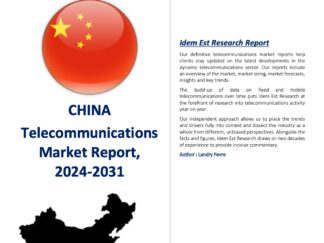Description
WHY YOU SHOULD BUY THE SINGAPORE TELECOMS INDUSTRY REPORT:
- Benefit from the latest market opportunities
- Understand the threats to your operations and investments and protect your company against future risks
- Gain insights on emerging trends supporting, enhancing or disrupting your activities in the market
- Get a full view of the competitive landscape to assess your market position.
- Forecasts as a key input for successful budgeting and strategic business planning in the telecoms market
- Target business opportunities and risks in the telecoms sector through our reviews of latest industry trends, regulatory changes and major deals, projects and investments
- Assess the activities, strategy and market position of your competitors, partners and clients via our Operators Profiles
The Singapore Telecommunications Industry Report, 2024-2031 includes a comprehensive review of the Singaporean market dynamics, market sizing, market forecasts, analysis, insights and key trends.
EXECUTIVE SUMMARY
Singapore Telecoms Industry Report at a Glance
Singapore has one of the most mature and competitive telecommunications markets in the world. Singapore is a world leader in telecommunications, with a progressive regulatory environment and a highly competitive market. It continues to promote itself as an information technology hub, driven by innovation.
Idem Est Research forecasts that mobile subscriptions will grow and fixed broadband subscribers during over the period 2023-30. Internet user penetration will grow at an annual average rate of 1.7% in the forecast period and 95% of the population by 2030.
In 2024, the Singaporean telecommunications market represented 1.1% of Singapore’s GDP, a proportion in line with other developed countries. The government has completed the rollout of its Next-Generation National Broadband Network (NGNBN). This is a hybrid network based on a combination of fibre-to-the-home (FTTH) and wireless infrastructure and continues to form the basis of the government’s broadband strategy and implementation. The project is broadly regarded as a successful government policy, delivering world-leading gigabit services at affordable prices. Singapore is now in the fortunate position of being the world-leader in fixed broadband.
In 2019, Singapore Press Holdings and Singapore-based conglomerate Keppel Corporation announced their plan to acquire a majority controlling stake in telecom company M1, from Malaysian headquartered Axiata. In 2021, Keppel proposed an SGD1.6 billion acquisition of Singapore Press Holdings’ real estate assets. Keppel Corporation offered to acquire the non-media business of Singapore Press Holdings (SPH), including jointly-owned telco (M1) and data centre assets.
Simba (ex-TPG), the fourth new entrant with newly introduced SIM only plans and large download plans for less than USD7 will drive down unit pricing and bring Singaporean in line with other neighbouring countries.
Capex Investments
The Capex from Singaporean operators is cyclical with mobile rollout leading to investments in line with the operators’ top-line growth. Capex investments peaked between 2016 and 2017 while all three operators built their respective 4G mobile network. Capex investments increased again in 2020 and will continue through to 2027, as mobile operators invest in 5G. Singapore sees 5G as the backbone of a wide range of technological advances including autonomous vehicles, smart cities and Internet of Things. All three mobile operators launched 5G services in 2020. The Capex to GDP ratio spiked between 2015 and 2016 and started to slide downwards and growing from 2020 onwards.
Idem Est Research projects an increase in Capex spend throughout 2024 alone by installing more 5G base stations across all cities, ramping up Singapore’s 5G rollout island-wide and consolidating its 5G network leadership in terms of speeds and availability in the country.
Operator Profiles
The Singaporean three-player mobile market is a remarkably stable market, however with mobile revenue pressure, all operators are broadening their range of services from e-commerce, smart home to digital payments.
Between 2017 and 2024, both both revenue and EBITDA shares remained remarkably stable, with only Singtel losing some share of the telecoms market EBITDA pool in 2024.
Mobile Subscribers and Revenue
Average annual mobile revenue growth was much lower (-5.4%) than mobile service subscriptions growth (2.4%) during the period 2017-2023, highlighting the structural challenges faced by mobile operators. Declining voice & SMS revenue only partially offset by wireless data monetisation is putting pressure on ARPU, compounded by bundling discounts to stem churn.
IoT connections is a major growth driver for mobile operators, a slowdown in mobile subscriptions growth will put long term pressure, dialling up competition for the three mobile operators fighting for fewer new customers.
According to our benchmark study of mobile data pricing, Singapore had among the biggest cost reduction per GB over the last 3 years, while India has the lowest rate in the world with just a few cents per GB.
The Singaporean mobile market rapidly transformed from a voice and SMS to a mobile Internet-dominated market. With a continued drive to convert smartphones users to digital shoppers and therefore increasing mobile operators’ consumers share of wallet. Mobile operators are increasing market segmentation and deliver innovative offerings targeting households with digital services such as music, video streaming, digital payments and bundles of other services such as home automation, IPTV and fixed broadband.
Broadband Subscribers – FTTH Push to Gigabit Speeds
After over 10 years of investments in fibre infrastructure, Singapore boasts the highest FTTH penetration in the world as well as one of the most advanced, consumer broadband products offering speeds up to 10Gbps. Most people use above 1GBps packages which are mostly bundled with mobile services by the three dominant players, Singtel, Starhub and M1.
Fixed broadband penetration is forecasted to grow modestly as Singapore’s investments in full-fibre networks are now reaching maturity with affordable packages and increased broadband household penetration growing towards saturation.
Thematics – Telecoms Infrastructure / 5G / M&A / Infrastructure
Infrastructure funds, pension funds and government funds are assigning high valuation multiples to telecommunications infrastructure assets such as mobile towers, data centres, submarine cable and fibre infrastructure.
Investment funds are assigning high valuation multiples to telecommunications infrastructure assets such as mobile towers, data centres, submarine cable and fibre infrastructure. This report outlines some real market examples of how investors view and value these investments with real industry examples and EV/EBITDA comparatives and benchmarks.
Our Singapore Telecoms Industry Report transactions database analysis highlights the dearth of inbound (domestic) transactions in the Singapore telecommunications services market, with the largest transactions from Keppel with M1 purchase and Starhub bulking up its fixed broadband and IPTV business units and consolidating their position by acquiring smaller operators. Most other transactions are expected in the data centre, IoT and cloud computing sector with Singtel investing in e-Commerce and enterprise services.
KEY COMPANIES MENTIONED IN THIS SINGAPORE TELECOMS INDUSTRY REPORT:
Circles.Life, Keppel, M1, MyRepublic, Netlink Trust, Starhub, Simba, Singtel, TPG
Singapore Telecoms Industry Report – Table of Contents
1 Key Statistics
1.1 Singapore’s Population
1.2 Singapore’s Economy
2 Overall Telecommunications Market, 2017–2031
2.1 Market Overview
2.2 Singapore’s Race to Lead in 5G and Beyond
2.3 Historical Telecommunications Market Revenue, 2017-2023
2.4 Overall Telecommunications Market Forecast, 2023-2031
2.5 Telecommunications Market Capital Expenditure, 2017-2031
2.5.1 Historical Telecommunications Capex Spend, 2017-2023
2.5.2 Capex to Revenue Country Benchmark
2.5.3 Capex to GDP Benchmark
2.5.4 Telecommunications Capex Spend Forecast, 2023-2031
3 Telecommunications Operators Profile
3.1 Singtel Profile
3.1.1 Singtel Revenue and EBITDA Mix
3.2 Starhub Profile
3.2.1 Starhub Revenue and EBITDA Mix
3.3 M1 Profile
3.3.1 M1 Revenue and EBITDA Mix
3.4 SIMBA (TPG Singapore)
3.4.1 SIMBA Singapore and EBITDA Mix
4 Singapore Mobile Market
4.1 Singapore Mobile Subscribers Historical and Forecast, 2017-2031
4.1.1 Singapore Mobile Subscribers Historical, 2017-2023
4.1.2 Singapore Mobile Subscribers Market Share, 2017-2023
4.1.3 Singapore Smartphone Share, 2023
4.1.4 Singapore Mobile Subscribers Forecast, 2023-2031
4.1.5 Singapore Mobile Subscribers by Generation Forecast, 2023-2031
4.2 Singapore Mobile Revenue Historical and Forecast, 2017-2031
4.2.1 Historical Singapore Mobile Revenue, 2017-2023
4.2.2 Singapore Mobile Subscribers ARPU, 2017-2023
4.2.3 Singapore Mobile Revenue Forecast, 2023–2031
4.3 Spectrum Holdings
4.3.1 Spectrum Regulation
4.3.2 5G and Other Spectrum Auctions
4.3.3 Mobile Frequencies Portfolios Analysis
4.3.4 Spectrum Depth Benchmark by Country
4.4 Mobile Download Data and Pricing Trends
4.5 Mobile Speed Tests
4.5.1 Ookla Mobile Speed Tests
4.5.2 OpenSignal
4.6 Mobile Virtual Network Operators (MVNO)
4.7 Internet of Things (IoT)
5 Broadband Market
5.1 Fixed Broadband Subscribers Historical, 2017-2024
5.2 Fixed Broadband Subscribers Forecast, 2023-2031
6 Satellite Internet Connectivity
6.1 Comparing LEO, MEO, and GEO Satellite Orbits
6.1.1 LEO and GEO Satellite Comparison
6.2 Satellite Broadband Providers Operators, 2024
6.3 5G NTN: The Next Generation of Satellite Connectivity
6.3.1 5G NTN Overview
6.3.2 The Rationale Behind 5G NTN
6.3.3 Technical Aspects of 5G NTN
6.3.4 Potential Applications for 5G NTN
6.3.5 Challenges in Implementation
6.3.6 5G NTN Satellite Providers
6.4 Satellite Internet Market Analysis, 2023-2031
6.4.1 Market Landscape of Satellite Broadband Subscribers, 2024
7 Fixed Telecommunications Infrastructure Investments
7.1 Fixed Digital Infrastructure
7.1.1 Overview of the National Broadband Network
7.2 Submarine Cables
8 Singapore Telecom Towers Infrastructure Landscape
8.1 Singapore Telecom Towers Market Analysis, 2024
8.1.1 Singapore Telecom Towers Market Overview
8.1.2 Tower Density Benchmark
9 Thematics / Opportunities
9.1 Consolidation Opportunities
9.2 Diversification Opportunities
9.3 6G Developments
10 Telco Transactions Database
11 Methodology
12 Copyright Notice
Singapore Telecoms Industry Report – List of Figures
Figure 1 – Telco sector revenue as % of GDP in Singapore
Figure 2 –Revenue Profile Historical Mix (SGDm), 2017 – 2023
Figure 3 –EBITDA Profile Historical Mix (SGDm), 2017 – 2023
Figure 4 – Telecommunications Market Revenue, 2023
Figure 5 – Telecommunications Market EBITDA, 2023
Figure 6 – Telecommunications Revenue & EBITDA Share, 2023
Figure 7 – Total Telecoms Market Revenue and Growth Rate (SGD bn), 2023-2031
Figure 8 – Capex to Revenue Benchmark, 2017-2023
Figure 9 – Capex to GDP Ratio Benchmark, 2017-2023
Figure 10 – Telecommunications Capex Spend (SGDm), 2000-2031
Figure 11 – Singtel Revenue Mix – 2023
Figure 14 – Starhub Revenue Mix – 2017-2023 (SGDm)
Figure 15 – Starhub Historical Revenue Mix, 2017 – 2023 (SGDm)
Figure 16 – M1 Revenue Mix – 2017-2022 (SGDm)
Figure 17 – M1 Historical Revenue Mix, 2017 – 2023 (SGDm)
Figure 18 – Singapore Mobile Subscribers Share Comparison, 2017-2024
Figure 19 – Singapore Mobile Subscriber Share Comparison, 2017-2023
Figure 20 – Mobile Net Adds (000’s) Comparison, 2017-2024
Figure 21 – Singapore Mobile Subscribers Forecast, 2023-2031
Figure 22 – Mobile Subscribers by Generation Forecast, 2023-2031
Figure 23 – Mobile Subscribers ARPU (SGD), 2017-2031
Figure 24 – Singapore Mobile Revenue Forecast, 2023-2031
Figure 25 – Subscriptions per MHz of Spectrum, Select Asia-Pacific Countries, 2024
Figure 26 – Mobile Handsets Monthly Download Data, 2017-2023
Figure 27 – Data Pricing Trends in Asia-Pacific (US$ per GB per month), 2017-2023
Figure 28 – Asia Pacific Data Pricing Benchmark, 2024
Figure 28 – MVNO Share of the Mobile Market, 2024
Figure 29 – Spectrum Available and IoT Landscape in Singapore
Figure 30 – Broadband Subscribers Share Comparison, 2017-2024
Figure 31 – Singapore Net-Adds (000’s) by Operators, 2017-2024
Figure 32 – Singapore Broadband Subscribers Forecast, 2023-2031
Figure 34 – Satellite Deployments Type
Figure 35 –Starlink and OneWeb Satellite Launches per Month (Data until Sep-24)
Figure 33 – Singapore Tower Market Share, 2024
Figure 34 – Capita per Tower, 2024
Singapore Telecoms Industry Report – List of Tables
Table 1 – Singapore – Key Statistics
Table 2 – Singapore Telecommunications Market Revenue by Operators, 2017-2023
Table 3 – Total Telecommunications Market Revenue, 2023-2031
Table 4 – Historical Telecommunications Capex Spend, 2017-2023
Table 5 – Historical Singtel Revenue, EBITDA & Capex, 2017-2023
Table 6 – Starhub Revenue and EBITDA Mix, 2017-2023
Table 7 – M1 Revenue, EBITDA and Capex, 2017-2023
Table 8 – SIMBA Singapore Revenue and EBITDA Mix, 2020-2023
Table 9 – Singapore Historical Mobile Subscribers, 2017-2023
Table 10 – Singapore Mobile Subscribers Forecast, 2023-2031
Table 11 – Singapore Mobile Subscribers by Generation (3G, 4G, 5G& 6G) Forecast, 2023-2031
Table 12 – Historical Mobile Service Revenue, 2017-2023
Table 13 – Historical Mobile ARPU, 2017-2023
Table 14 – Mobile Service Revenue Forecast, 2023-2031
Table 15 – Spectrum Holdings by Operators and by Bands (MHz)
Table 16 – Mobile Frequencies by Operators and by Band (MHz)
Table 17 – Examples of MVNOs and their Wholesale Providers
Table 18 – Historical Broadband Subscribers, 2017-2024
Table 19 – Historical Broadband ARPU, 2017-2023
Table 20 – Singapore Broadband Subscribers Forecast, 2023-2031
Table 21 – Satellite Orbit Altitudes
Table 22 – LEO and GEO Satellite Comparison
Table 23 – Satellite Broadband Subscribers Operators, 2024
Table 24 – 5G NTN and Satellite Providers, 2024
Table 21 – International Submarine Cable Systems with Landing Stations in Singapore
Table 23 – Telco Transaction Database, 2016-2024
Other Idem Est Research Telecoms Country Reports
Australia, Bangladesh, China, India, Indonesia, Japan, New Zealand, Malaysia, Myanmar, Pakistan, Philippines, Singapore, South Korea, Taiwan, Thailand, Vietnam,
Asia Pacific Telecom Towers, Asia Pacific Satellite Internet, Starlink Company Profile






